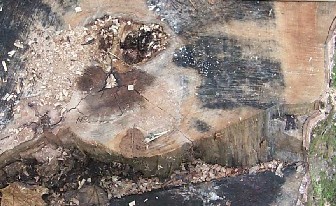
| Home |
| Tutorial |
| Photo Gallery |
| List of Defects |
| Links |
| Bark Distortion |
| Bird Peck |
| Bumps |
| Burls |
| Butt Scars |
| Butt Swells |
| Cankers |
| Conks |
| Epicormic Branches |
| Flanges |
| Flutes |
| Forks |
| Galls |
| Holes |
| Knots |
| Lesions |
| Limbs |
| Ring Shake |
| Rot |
| Seams |
| Soak |
| Splits |
| Wounds |
Significance: The occurrence of ring shake anywhere in the quality zone of a log is serious.
In veneer logs, ring shake that shows outside the heart center is admitted in all logs when confined to a one-quarter segment on one end. If it occurs on both ends, it must be confined to the same one-quarter segment in logs 12 to 15 inches (30.5 to 38.1 cm) diameter inside bark (d.i.b.). It can be in different one-quarter segments in logs 16 inches (40.6 cm) and larger d.i.b. In each case it is subject to a log-scale deduction.
In factory logs, ring shake in the heart center or in definitely localized areas in the periphery is scaled out. The shake confined to the heart center is not a grading defect, but peripheral ring shake is a log grade defect because it will stop cuttings. If ring shake occurs throughout the log, there is good reason to cull the log and send it to the chipper.
In construction logs, ring shake is a log grade defect. Tie and timber grades admit one ring shake that is no more than one third the width of the tie or timber.
In standing trees, there is no positive exterior indicator of ring shake. However, there are several clues as to the presence of ring shake in large, old trees. These are lean, sweep, crook, large overgrown knots, and stem deformations such as burls, galls, cankers, butt scars and bulges, and stem bulges. Other clues considered are the relationships of site, soil, slope, and other factors of this sort to species that are prone to ring shake.

